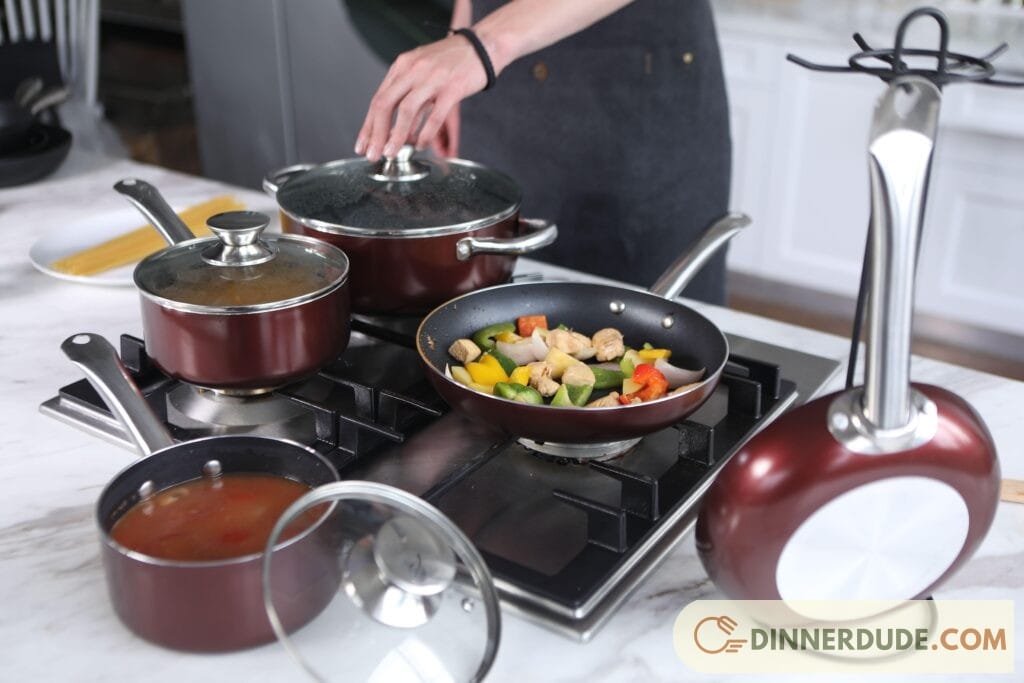Non-stick cookware has become extremely popular due to its convenience and ease of cleaning. So, Is non-stick cookware harmful to health?
There have been longstanding concerns about potential health risks, especially from exposure to chemicals used in the non-stick coatings. This article by Dinnerdude will help you better understand the issues surrounding non-stick pans, help determine when they can be dangerous, and provide instructions on how to use them more safely.
Is non-stick cookware harmful to health?

Concerns Over PFOA Chemicals
Traditional Non-Stick Coatings Contain PFOA Traditional Teflon non-stick coatings contain PFOA (perfluorooctanoic acid), which can be toxic and may pose health risks with exposure over time.
PFOA is considered an endocrine disruptor and has been linked in human and animal studies to some cancers, liver damage, thyroid disease and other problems.
PFOA Exposure From Cookware Studies found PFOA and related chemicals can enter food from non-stick pans during normal cooking.
This low-level chemical exposure over months and years could potentially impact health, though more research is still needed on risks from cookware specifically versus other exposure routes.
The Perils of Overheating
Teflon is a relatively safe and stable material.
Teflon coatings on nonstick cookware begin to break down at temperatures above 500°F (260°C), releasing toxic chemicals into the air (18Trusted Source).
Polymer fume fever, also known as the Teflon flu, can result from inhaling these fumes.
While the health effects of overheated Teflon can be severe, using commonsense cooking techniques can help you avoid exposure.
Safer Modern Non-Stick Alternatives

Ceramic and Titanium Non-Stick
Many newer non-stick pans use ceramic or titanium coatings to provide non-stick performance without PFOA or other potentially harmful chemicals.
These modern non-stick options are considered safe and inert. The slick surfaces provide convenience without the risks.
Cast Iron and Stainless Steel
Uncoated pans like cast iron or stainless steel pose no health risks from non-stick coatings, as they don’t have one.
While these surfaces may require a little more oil or fat for cooking, many chefs and health-conscious cooks prefer their natural surfaces for safety and even heating.
Proper Usage Reduces Risks

Ventilation When Overheating: The non-stick surface can degrade if overheated past manufacturers’ recommendations, potentially releasing small amounts of chemicals. Proper ventilation from opening windows or using a vent hood reduces exposure to fumes.
Avoid Metal Utensils: Scratching the non-stick coating with metal utensils also degrades the surface over time and can release particles into food. Using only wood, plastic, or silicone utensils helps maximize safety when cooking with non-stick.
Preheating an empty pan is not recommended. Empty pans can quickly reach high temperatures, potentially releasing polymer fumes. Before preheating, make sure you have some food or liquid in your pots and pans.
Cooking on high heat should be avoided. Cook on medium or low heat and avoid broiling, as this technique necessitates temperatures higher than those recommended for nonstick cookware.
Utensils made of wood, silicone, or plastic should be used. Metal utensils can scratch and scuff the nonstick surface, shortening the life of your cookware.
Hand wash only: Wash pots and pans gently with a sponge and soapy, warm water. Steel wool and scouring pads should be avoided because they can scratch the surface.
Replace worn-out cookware: Teflon coatings should be replaced when they begin to visibly deteriorate with excessive scratches, peeling, flaking, and chipping.
The health risks of non-stick pans are still being evaluated, but choosing safer materials and proper usage can reduce potential hazards.
